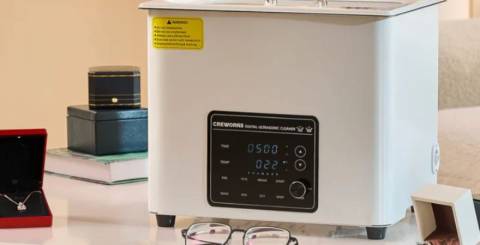The Chemistry Behind Ultrasonic Cleaning Solutions

Ultrasonic cleaning is a powerful, non-invasive method for removing contaminants from surfaces. Using high-frequency sound waves, ultrasonic cleaners create microscopic bubbles that implode upon contact with dirt, oils, or grime, effectively lifting them off.
However, the effectiveness of this process heavily depends on the type of ultrasonic cleaning solution used, making it critical to understand the chemistry behind these solutions.
How Ultrasonic Cleaners Work
Ultrasonic cleaners generate sound waves that create cavitation bubbles in the cleaning solution. As these bubbles form and collapse, they release energy that disrupts contaminants on the surface of items. The choice of cleaning solution plays a vital role in enhancing this cavitation effect by reducing surface tension, allowing the bubbles to penetrate hard-to-reach areas more efficiently.
Types of Ultrasonic Cleaning Solutions
● Aqueous-based Solutions: These water-based solutions often contain surfactants, which help break down oils and greases. They are eco-friendly and versatile, making them ideal for cleaning a wide range of materials such as glass, ceramics, and metals.
● Solvent-based Solutions: Solvent-based cleaners are often used for more stubborn contaminants like adhesives, heavy oils, or waxes. These are typically used in industrial applications where tougher cleaning is required.
● Enzyme-based Solutions: For organic materials such as proteins or fats, enzyme-based solutions are highly effective. Commonly used in the medical and dental industries, they offer a gentle yet thorough cleaning process for instruments.
Benefits of Ultrasonic Cleaning Solutions
Ultrasonic cleaning offers several benefits over traditional methods of cleaning, making it an effective and adaptable choice for industries that demand consistency and precision:
Deep Cleaning and Precision: Ultrasonic cleaning solutions reach microscopic crevices and complex geometries that traditional methods cannot, ensuring a uniform clean on every part of the item.
Time and Labor Efficiency: With most cycles completed within 5-20 minutes, ultrasonic cleaning saves time and requires minimal human labor, as it’s largely an automated process.
Environmental Friendliness: Most water-based ultrasonic cleaning solutions are biodegradable, non-toxic, and don’t require harsh chemicals, making them a safer choice for both users and the environment.
Material Safety: Ultrasonic cleaning is gentle enough for sensitive materials, reducing the risk of scratches, abrasions, or other damage that could occur with manual cleaning methods.
Cost-Effectiveness: Although ultrasonic equipment can be an investment, the reduced need for labor, faster turnaround times, and decreased chemical usage make it a cost-effective solution over time.
Choosing the Right Cleaning Solution
When selecting a cleaning solution, several factors come into play. The material of the item being cleaned, such as metal, plastic, or fabric, will determine the solution’s chemical composition. Additionally, the type of contaminant—whether it’s biological residue, oil, or rust—will guide the selection process. For instance, medical equipment requires enzyme-based solutions, while jewelry might require a specialized metal cleaner.
For a reliable and effective solution, Creworks ultrasonic cleaning solutions offer high-quality, specially formulated options that cater to various industries. These solutions are biodegradable and non-toxic, making them a safe choice for users aiming to reduce environmental impact without sacrificing cleaning performance.
Applications of Ultrasonic Cleaning
Ultrasonic cleaning is used across various industries:
● Medical and Dental: Cleaning and sterilizing instruments.
● Automotive: Removing oil, grease, and dirt from engine parts.
● Jewelry: Polishing precious metals and gemstones.
● Manufacturing: Preparing surfaces for coatings or assembly by removing contaminants like oils and rust.
Each application requires specific cleaning solutions to ensure optimal results without damaging the items being cleaned.
Best Practices and Maintenance
Using ultrasonic cleaning solutions correctly is key to maintaining both the machine and the items being cleaned. Regularly changing the solution prevents recontamination and ensures consistent cleaning results. Following the manufacturer’s guidelines on dilution and temperature is also crucial for maintaining the effectiveness of the cleaning process.
For delicate materials, like soft metals or certain plastics, use mild cleaning agents to prevent damage. Always ensure the items are compatible with ultrasonic cleaning to avoid potential harm.
Conclusion
In ultrasonic cleaning, the chemistry of the solution plays a vital role in achieving optimal results. By selecting the right solution based on the material and type of contaminants, industries can ensure thorough, efficient, and safe cleaning processes. Understanding these solutions helps prolong the lifespan of materials, whether for industrial, medical, or personal use.
Similar Articles
Global markets are becoming more interconnected and quite evidently at that. The result? Shorter product lifecycles have led to unprecedented pressure for businesses to optimize operations. And maintain a competitive advantage, of course.
Using the power of big data analytics can change the way businesses operate. Analysis of large datasets lets companies gain detailed information about their customers and markets, allowing them to remain competitive.
The market is brimming with all sorts of software solutions and whatnot. Yet, software as a service has managed to establish itself as the dominant software delivery model. Businesses are now increasingly switching to cloud apps to improve efficiency and drive innovation. And embracing SaaS is driving an increase in demand for adaptable and scalable software solutions
The global conveyor system market, valued at $6.4 million in 2024, is likely to reach $11 million by 2034.
Content has permanently changed. We essentially have the digital revolution to thank for it. You see, how content is created and consumed has been fundamentally transformed.
Explore how enterprise software simplifies complex testing with secure, scalable solutions, streamlining exam creation, administration, and data management for institutions.
Using fiber optic technology, HDMI cables can transmit video and audio signals without compromising on quality over extensive distances.
Explore the OSFP transceiver: a high-speed, future-ready solution for data centers. Learn its advantages in bandwidth, thermal performance, and signal integrity.
The financial technology sector, commonly known as fintech, is experiencing profound changes due to the rise of data science. Integrating extensive data methodologies enhances existing services and unravels new opportunities that were previously unimaginabl









